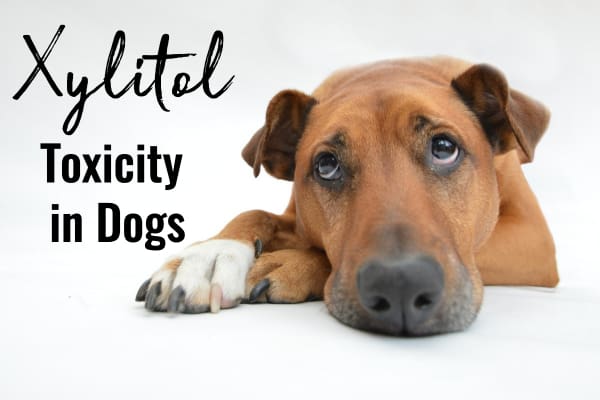My Dog Ate Xylitol and Is Fine Now: Here’s What You Need to Know in 2024

Dog Ate Xylitol and Is Fine – Understanding Xylitol and Its Dangers to Dogs.If your dog ate xylitol and seems fine, it’s important to grasp why xylitol is so dangerous. Xylitol is a sugar substitute used in many sugar-free products, such as gum, candy, and some peanut butters. Though it’s safe for people, it’s extremely toxic to dogs, even in small amounts.
Xylitol triggers a rapid release of insulin in dogs, which can cause a severe drop in blood sugar, or hypoglycemia. This can lead to symptoms like weakness and confusion and may even result in liver failure. Even if your dog looks healthy now, it’s crucial to get veterinary advice to ensure there are no hidden health risks.But if you hear that- my Dog Ate Xylitol and Is Fine! Let’s explore!
My Dog Ate Xylitol and Is Fine: Why Immediate Symptoms May Not Appear
Even if your dog seems fine after eating xylitol, or you may think that my Dog Ate Xylitol and Is Fine! it’s important to understand why immediate symptoms might not be apparent. The absence of symptoms right away does not mean that your dog is out of danger. Here’s why symptoms may be delayed:
Why Immediate Symptoms May Not Appear
Some Dogs Do Not Show Symptoms Right Away, Depending on the Amount Ingested and the Dog’s Size
- Amount Matters: The severity of xylitol poisoning can vary based on how much xylitol your dog ingested. Smaller amounts might take longer to trigger symptoms, leading to a delay in noticeable effects.
- Size Differences: Your dog’s size plays a crucial role in how quickly symptoms manifest. Smaller dogs may react more quickly to xylitol, whereas larger dogs might show symptoms later or less noticeably.
Symptoms Can Be Delayed, Appearing Hours or Even Days After Ingestion
- Delayed Onset: Xylitol poisoning can have a delayed onset of symptoms. Even if you think that my Dog Ate Xylitol and Is Fine ! Ok, your dog appears fine initially, symptoms such as vomiting, lethargy, or coordination issues might not appear until several hours or days later.
- Gradual Development: The toxic effects of xylitol, including hypoglycemia and liver damage, can develop gradually. This delayed reaction can make it challenging to assess the immediate risk based on your dog’s current condition.
Initial Absence of Symptoms Does Not Guarantee That the Dog Is Safe
- Not a Guarantee: Just because your dog is not showing symptoms immediately does not mean they are out of danger. The potential for delayed symptoms means that your dog could still experience serious health issues even if they seem fine at first.
- Continuous Monitoring Needed: It’s crucial to monitor your dog closely for any signs of distress and consult with a veterinarian, even if your dog appears unaffected initially. Proactive care can help address any potential issues before they become severe.
Understanding these factors that Dog Ate Xylitol and Is Fine-highlights the importance of not assuming that your dog is safe based solely on the absence of immediate symptoms. Continuous observation and veterinary consultation are key to ensuring your dog’s health and safety following xylitol ingestion.
Common Symptoms of Xylitol Poisoning to Watch For
Even if your dog appears fine after ingesting xylitol, or you may think that my Dog Ate Xylitol and Is Fine! it’s crucial to be aware of the common symptoms of xylitol poisoning. Recognizing these signs early can help ensure timely veterinary care and prevent severe health issues. Here are the symptoms to watch for:
Common Symptoms of Xylitol Poisoning to Watch For
Vomiting and Diarrhea May Be Early Signs of Poisoning
- Early Indicators: Vomiting and diarrhea can be some of the first signs that your dog has ingested xylitol. These symptoms may appear shortly after ingestion and indicate that the body is reacting to the toxic substance.
- Monitor Closely: Keep an eye on your dog’s digestive health, and note any changes in their stool or frequency of vomiting. These early symptoms should prompt you to seek veterinary advice.
Symptoms Like Lethargy, Weakness, Loss of Coordination, or Collapse Can Develop
- Lethargy and Weakness: As xylitol poisoning progresses, your dog may become unusually tired or weak. They might show less interest in activities or appear unusually lethargic.
- Loss of Coordination: Watch for signs of uncoordinated movements or stumbling, which can be indicative of worsening conditions.
- Collapse: In severe cases, your dog may collapse or become unable to stand, which signifies a critical health issue that requires immediate medical attention.
Severe Cases Can Lead to Seizures, Tremors, or Liver Failure
- Seizures and Tremors: In the most severe instances of xylitol poisoning, your dog may experience seizures or muscle tremors. These symptoms are serious and indicate significant toxicity.
- Liver Failure: Xylitol can cause liver damage or failure, which might present as jaundice (yellowing of the skin or eyes), severe vomiting, and loss of appetite. Liver failure can be life-threatening and requires urgent veterinary care.
Understanding these symptoms helps you stay vigilant and seek prompt medical attention if needed. If you notice any of these signs or are concerned about your dog’s condition, contact your veterinarian immediately to ensure your dog’s well-being.
What to Do If Your Dog Ate Xylitol and Appears Fine
If your dog has ingested xylitol and seems fine, or you may think that my Dog Ate Xylitol and Is Fine! it’s important to take specific steps to ensure their safety. Xylitol poisoning can be serious, even if no immediate symptoms are present. Here’s what you should do:
What to Do If Your Dog Ate Xylitol and Appears Fine
Contact Your Veterinarian or a Pet Poison Control Hotline Immediately for Advice
- Seek Professional Guidance: Reach out to your veterinarian or a pet poison control hotline as soon as possible. They can provide expert advice based on the amount of xylitol ingested and your dog’s condition.
- Provide Details: Inform them about the type and amount of xylitol your dog consumed. Accurate information will help them give you the best guidance for your situation.
Do Not Wait for Symptoms to Appear; Immediate Action Is Crucial
- Act Promptly: Don’t wait for symptoms to develop before taking action. Xylitol poisoning can cause serious health issues that may not be immediately apparent. Early intervention can be critical in preventing severe complications.
- Follow Advice: Adhere to the instructions provided by veterinary professionals. They will guide you on the best course of action to ensure your dog’s safety.
Avoid Inducing Vomiting Unless Instructed by a Veterinary Professional
- Follow Instructions: Do not induce vomiting unless specifically directed by a veterinarian or poison control expert. Inducing vomiting improperly can cause additional harm or might not be necessary if your dog is not showing symptoms.
- Wait for Guidance: Allow veterinary professionals to advise you on whether vomiting is appropriate and, if so, how to proceed safely.
Taking these steps ensures that you’re acting in the best interest of your dog’s health and safety. Quick and informed action is key to managing potential xylitol poisoning effectively.
Potential Long-Term Health Effects of Xylitol
Even if your dog seems fine after ingesting xylitol, or you may think that my Dog Ate Xylitol and Is Fine! it’s important to be aware of potential long-term health effects. Xylitol poisoning can have delayed and severe consequences, even if immediate symptoms are mild or absent. Here’s what you need to know:
Potential Long-Term Health Effects of Xylitol
Even If Initial Symptoms Are Not Severe or Are Absent, Xylitol Can Still Cause Liver Damage
- Liver Damage Risk: Xylitol can cause significant liver damage, which might not be immediately apparent. The liver’s function can be compromised even if your dog initially seems unaffected.
- Serious Consequences: Severe liver damage can lead to long-term health issues and may require extensive treatment and management.
Dogs May Need Blood Tests to Check Liver Function and Monitor for Hypoglycemia
- Blood Tests: Your veterinarian may recommend blood tests to assess your dog’s liver function and check for signs of hypoglycemia. These tests are essential for detecting any hidden effects of xylitol ingestion.
- Regular Monitoring: Monitoring your dog’s blood sugar levels and liver function can help identify any potential issues early and ensure that appropriate treatment is provided.
Continuous Observation and Follow-Up Veterinary Visits May Be Necessary to Ensure No Hidden Health Issues Develop
- Ongoing Monitoring: Even if your dog appears to be doing well, continuous observation is crucial. Keep a close watch on your dog’s behavior and health for any delayed symptoms or changes.
- Follow-Up Visits: Schedule regular veterinary check-ups to monitor your dog’s health and ensure that no hidden issues have developed as a result of xylitol ingestion.
By staying vigilant and following through with veterinary advice, you can help prevent and manage any long-term health effects related to xylitol poisoning. Regular check-ups and blood tests will play a key role in maintaining your dog’s well-being and addressing any potential complications.
How to Prevent Xylitol Exposure in the Future
Ensuring your dog’s safety involves preventing future exposure to xylitol. Here are practical steps to minimize the risk:
How to Prevent Xylitol Exposure in the Future
Keep All Xylitol-Containing Products Stored Securely and Out of Reach of Pets
- Safe Storage: Store xylitol-containing products like sugar-free gum, candies, and baked goods in secure cabinets or high shelves. This prevents your dog from accessing them.
- Pet-Proofing: Use childproof locks or pet-proof containers to further ensure that your dog cannot reach these items.
Be Vigilant About Checking Ingredient Labels on Food, Gum, Medications, and Dental Products
- Read Labels: Always check ingredient lists for xylitol on all food products, gum, medications, and dental items. Xylitol is often included in sugar-free or low-calorie products.
- Know the Ingredients: Familiarize yourself with terms and ingredients that indicate the presence of xylitol to make informed choices about what you keep in your home.
Educate All Household Members and Guests About the Dangers of Xylitol for Dogs to Prevent Accidental Exposure
- Spread Awareness: Inform everyone in your household and any visitors about the risks of xylitol for dogs. Make sure they understand how to handle and store products containing xylitol safely.
- Clear Instructions: Provide clear guidance on what to do if xylitol is accidentally ingested by a dog and stress the importance of vigilance in keeping these products away from pets.
By taking these precautions, you can significantly reduce the risk of xylitol poisoning and help protect your dog from future incidents. Regular awareness and careful management are key to ensuring your pet’s continued safety.




